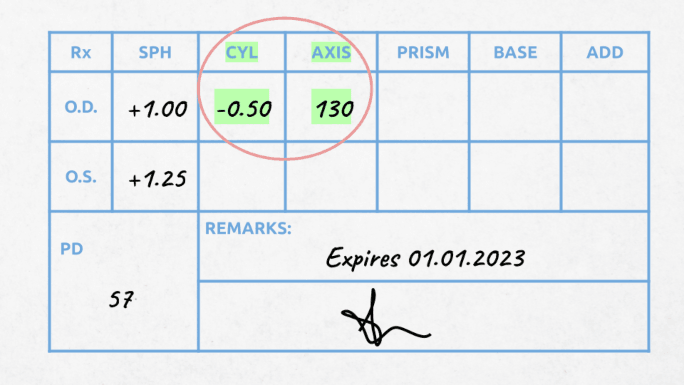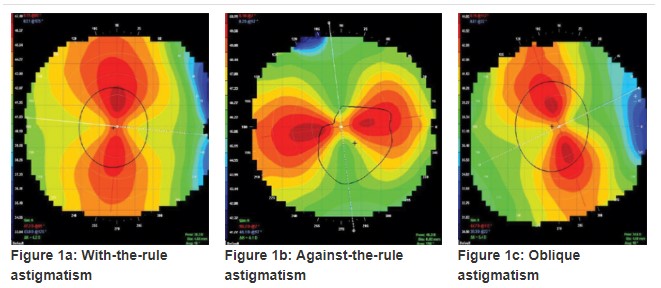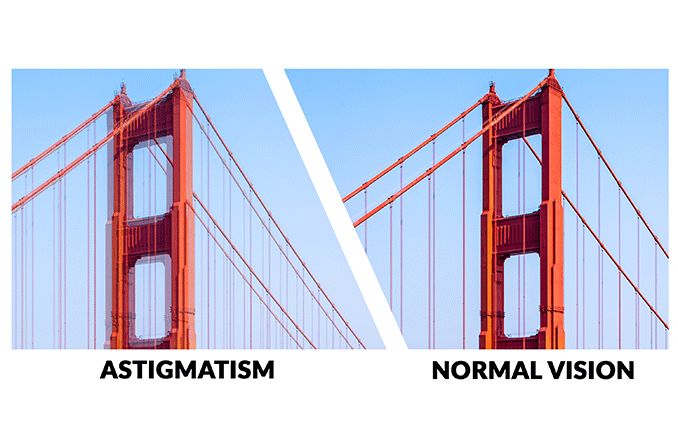Astigmatism test
Chart test
One of the most common in practice astigmatism test is the one in which patient is given a chart with radiating lines of equal length in a hemisphere as given below in the picture. Now close one of your eyes and focus on the lines on the chart. If the lines in any direction get blurry then note their axis. If you can see all the radiating lines clearly then congratulations you can say that your eye is good eye.
It has no dominant astigmatism at all. But if you are facing difficulty in seeing clear image and some of the lines are blurry then it means that you are having astigmatism. Note down the axis of the lines which are not clear. This is the angle for your astigmatism. Repeat the same procedure for another eye.

Prescription test
The prescription for glasses also reveals the astigmatism. If the patients are given a prescription of lenses with cylinders then it means that the patients have some amount of astigmatism as well. The axis written in the prescription for each eye is the angle at the cylindrical lens that has to be placed to correct the astigmatism. While prescribing the number for glasses the cylinders are rotated to get the best axis omitting blurredness.

Keratometry test
The keratometry can measure the corneal curvature thickness up to 3mm centrally. The radius of curvature of the cornea can be determined by finding the size of image formed by anterior surface of cornea. Then by applying formulas, we can find out results.

Topography astigmatism test
The topographer is the better choice as it can measure the entire corneal surface.
Astigmatism test at home
You can also check at home if you have an astigmatism or not. Here is the link to the video. Click here
What is an astigmatism
One of the most common things that people come across with is the astigmatism. It is unarguably one of the most common things that ocular physicians discover in the patients. When the eyes structures are not round and a little or more of in warp(distorted) condition at some point, then it is astigmatism. Hence it is the irregularity in the eye ball which results in stretchiness of the eyeball at one side.

This interferes with the normal light bending phenomenon in the eye which is the base of normal image formation in the eye as the difference in curvatures do not allow light to form image normally. Hence it results in blurry image formation. It does not come under the word disease. It is classified as a ‘condition’.
Corneal astigmatism
In normal cases cornea is smooth and curved surface. Corneal astigmatism occurs due to uneven curvature of cornea. We can find its value by measuring the difference between the steepest and flattest curves of cornea. The values of corneal curvatures lie between 39 D- 49 D. your ocular physician can measure this difference of curvature of cornea using different measurements. Sometimes the people are born with astigmatism which stabilizes with the passage of time.
Treatment for lenticular astigmatism
The lenticular astigmatism occurs due to lenticular changes that occur in the lens of eye with the passage of time. This astigmatism cannot be corrected with any outer aid. If it gets bad with the passage of time then the best option is toric IOL implant.
Other treatments
Once the astigmatism tests confirm the presence of measurement of astigmatism, the next target is fixing the condition. The astigmatism can be corrected with glasses or contact lenses or LASIK surgery.
Contact lenses is the brilliant option for astigmatism as they hold the cornea forming the shape of the surface of the eye which gives wider visual field. Toric lenses are best for astigmatic prescription.
What makes the astigmatism worse?
Excessive rubbing of eyeball and irritation in eye due to misdirected eyelashes can worsen the condition.
Range
The astigmatism can be vary from very mild to severe from 0.25D to 5D.
Founder of EyesMatterMost- an optometry student who loves talking about eyes. I tend to cover topics related to optometry, ophthalmology, eye health, eyecare, eye cosmetics and everything in between. This website is a medium to educate my readers everything related to eyes.



